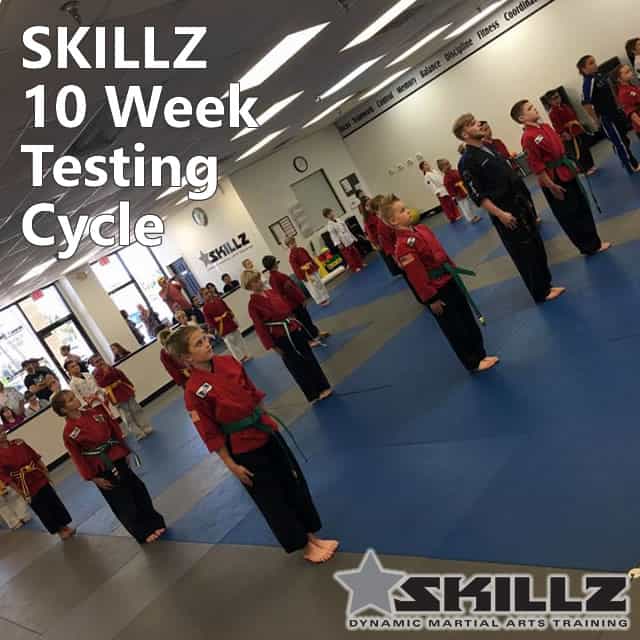Overview of SKILLZ 10-Week Testing Cycle
Almost every Martial Arts school operates with some sort of testing cycle. A testing cycle is the period in which the student learns rank-specific curriculum, and then “performs” or “tests” on that curriculum in a formal or informal setting in order to advance to the next belt rank. Most school’s testing cycle average between 8 to 12 weeks. Our school falls exactly in the middle with a 10-week cycle. The problem is most schools set up their testing cycle through trial and error. To make your job easier, we are going to break down how our testing cycle for our children’s curriculums are formatted. The purpose of this report is to show you how structured the SKILLZ program is, and answer a lot of your questions regarding our testing format.
In this report, we’ll cover the following topics associated with our 10-week testing cycle:
- Curriculum
- Skill Stripes
- 10-week overview
- Testing
Let’s get started!
Curriculum
It is very important that you have a structured curriculum for your students to follow. Without a curriculum, it is more challenging to determine when the student is ready for the next rank. At the same time, it is beneficial if each student has clear guidelines of what is required in order to advance to the next rank. A solid curriculum should include an overview of the categories they will train on along with a testing chart that lists all of their testing requirements for each rank.
For our children’s programs, we foster an age-specific skill-based training concept. This concept means that we use Martial Arts moves and traditions to help each child improve upon skills that the average children his or her age are developing. The skills are universal, so any style can incorporate this format by simply plugging in their style-specific curriculum to replace ours.
Here’s an overview of our children’s curriculums:
- 3 and 4-year olds: This curriculum focuses on early skills that children within this age group are developing – and with proper training – can be developed faster than the average child his or her age. EARLY SKILLZ are preliminary skills that preschoolers are learning. We cover the following EARLY SKILLZ one-at-a-time in each class:
- Kicking
- Punching
- Stepping
- Crawling
- Hopping
- Rolling
- Running
- Catching
- 5 and 6-year olds: This curriculum focuses on basic skills that children within this age group are developing – and with proper training – can be developed faster than the average child his or her age. BASIC SKILLZ are fundamentals that are developed during Kindergarten and First Grade. We cover the following BASIC SKILLZ one-at-a-time in each class:
- Focus
- Teamwork
- Control
- Memory
- Balance
- Discipline
- Fitness
- Coordination
- 7 to 9-year olds: This curriculum focuses on core skills that children within this age group are developing – and with proper training – can be developed faster than the average child his or her age. CORE SKILLZ are advanced fundamental skills that are typically developed during Second, Third, and Fourth Grade. We cover the following CORE SKILLZ one-at-a-time in each class:
- Agility
- Technique
- Courage
- Flexibility
- Intensity
- Perseverance
- Speed
- Control
- 10 to 14-year olds: This curriculum focuses on extreme skills that children within this age group are developing – and with proper training – can be developed faster than the average child his or her age. EXTREME SKILLZ are highly technical skills that are usually grasped once the child reaches Fifth Grade. We cover the following EXTREME SKILLZ one-at-a-time in each class:
- Dexterity
- Reaction
- Versatility
- Momentum
- Precision
- Instinct
- Strength
- Vision
- Elite and Black Belts: Once the student completes the color belt ranks of the EXTREME SKILLZ program, we move them into our ELITE SKILLZ program. This program is unique because we cover one topic per testing cycle, which we refer to as “instructor surprise.” Each cycle we surprise the Elites and Black Belts with a new curriculum from a list of categories to keep their training fresh and exciting. The categories: Weapons, Forms, Sparring, Board Breaking, Self-defense, Dynamic Kicking, Physical Challenge, and Cross Training. Within these categories, we cover the following ELITE SKILLZ one-at-a-time in each class:
- Gracefulness
- Rhythm
- Orientation
- Fluidity
- Execution
- Reflex
- Knowledge
- Timing
- Teens and anamolies: Just like the ELITE SKILLZ program, this curriculum focuses on one category at a time so that the students can hone in on special talents associated with an extreme style of martial arts. This program is non-traditional, which means the students wear tricking pants or shorts with a t-shirt. Instead of belts, they earn bracelets for ranking. The categories we rotate through include extreme weapons, forms, and tricking, all topics that teens and anamolies gravitate towards. Within these categories, we cover the following SIGNATURE skills one-at-a-time in each class:
- Force
- Sharpness
- Endurance
- Quickness
- Creativity
- Cadency
- Synching
- Performance
Skill Stripes
Skill stripes are like mini-tests in-between each regular testing. These are great for student management. The students know that they must earn all eight skill stripes in order to be eligible for testing. If they miss class or can’t perform the testing requirement, then they know what they need to practice on. The skills stripes are also great for student motivation as they accomplishing small goals when they earn a new stripe.
Here’s how it works:
- We cover one topic per class.
- The students are tested at the end of each class for the skill covered for that day according to their testing chart.
- If they can perform the testing requirements from the testing chart at a satisfactory level, then they earn a stripe.
- The skill stripes are color-coordinated with each skill, which makes student management easy.
- The students train two times per week, which means they cover two skills per week.
- All eight skills are covered in a four week span: two skills per week divided by eight skills = four weeks.
- We repeat the curriculum once again, which means that over a span of eight weeks, the students cover each skill twice.
- This means that the students have two shots to earn all eight skill stripes.
- If the student misses a class or does not earn their skill stripe for the day, then they know that they must be in class the next time the skill comes around, or they can book a private lesson to earn the stripe they missed.
- If the student earned their skill stripe the first round, then they are simply reviewing the second round.
10-Week Overview
Structure and organization is the key to a successful testing cycle. If you have your entire testing cycle organized for the entire year, then all you have to do is show up and teach a great class each and every day. At the same time if you “wing it” then you risk the chance that some students may not be as prepared. We provide our students with a healthy blend of curriculum training, review week, fun camps, and cycle breaks over the course of our 10-week testing cycle. This format guarantees our students success and at the same time gives us a small break in between each testing cycle.
Here’s an overview of our 10-week testing cycle:
- Weeks 1-4 – Introduction to the curriculum:
- The class planners during the first four weeks include a blend of fun drills and introductory skill training drills.
- Weeks 5-8 – Repeat weeks 1-4 with more emphasis on quality:
- The class planners during the second round of skill training include more intense skill training with an emphasis on repetition for better quality skill development.
- Week 9 – Review week and Testing:
- This week the students cover all eight of their skills in a “mock testing” format. This ensures that every student is not only prepared, but also can perform the skills at a higher caliber. At the end of review week, we host formal testing’s for the students. See the next section for more details.
- Week 10 – Fun camps and cycle break:
- On Monday and Tuesday of this week we host fun camps from 4pm to 6pm for all ages. Each student can bring a friend and we simply run the students through a blend of high-energy exercise drills and competitive games.
- From Wednesday – Sunday of this week we close our school for a cycle break. Since Martial Arts are year round, this is great for both the students and staff. Everyone has time off to rest, relax, and gear up for a new testing cycle.
Testing
We organize our testing by the program they are in. This enables us to run high-energy testing’s. The downfall is that we host a total of six testing’s between Wednesday night and Saturday. The upside is that we have a very high pass-rating and very high school spirit from both the students and audience.
Here’s a breakdown of our testing’s during week 9:
- Wednesday at 6:30pm – Elite Belts
- Thursday at 6:30pm – Black Belt Mid-Term Testing
- Friday at 6:00pm – EXTREME SKILLS testing for all ranks
- Saturday at 11am – EARLY SKILLS testing for all ranks
- Saturday at 12:00pm – BASIC SKILLS testing for all ranks
- Saturday at 1pm – CORE SKILLS testing for all ranks
Conclusion
Creating a successful testing cycle is a science and will vary based on a school’s style and student base. The key is to structure your testing cycle in a way that is easy to understand and fun to execute. If you have a highly-organized testing cycle, then you should experience a higher passer rating, better retention, and more school spirit.



